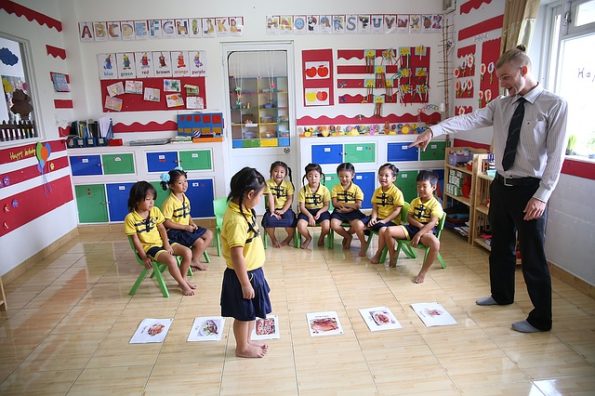[dropcap]I[/dropcap]magine you move to the United States from a foreign country and speak a foreign language. You get dropped off at an elementary school and it’s a whole different world. Children and teachers communicating in English, books filled with English, homework in English, and you can’t even get a break for lunch as the menu is in English. You are overwhelmed by everything in English and feel isolated and detached. So, you get placed in an English-Language Learner, or ELL, program which gives you modified work in both your native language and English.
Despite the ELL program’s best intentions, most students enrolled in it, as stated in an article by the Glossary of Education Reform, “underperform on standardized tests, dropout of school at significantly higher rates, and decline to pursue postsecondary education.” Many teachers are not equipped with the resources to teach these students, and the students suffer. Students are left alone, helpless, and confused.
I would argue this is a result of schools in America not teaching all children a second language when they are young.
A study done by the American Academy of Arts and Sciences shows only 20% of Americans are bilingual, and 57% of those people are immigrants who were born in a foreign country. If we assume the foreign-born immigrants are bilingual, then it leaves us with roughly 8.6% of Americans who went to school in the United States and are bilingual.
America should not be relying on people from other countries to learn English in order to communicate. Instead, we should be teaching two languages to children starting when they are in elementary school. This will create a much more diverse culture and inclusive country.
Enhanced Academics & English
Students who are bilingual throughout their school career show better academics and improved English. A study done by Brown University supports and offers explanations behind these reasons. It says, “[C]hildren discover so much about English as they learn the structure of other languages and encounter vocabulary that unlocks the meanings of many English words.” Students can better understand English when learning a foreign language, allowing them to perform better on tests.
[perfectpullquote align=”right” bordertop=”false” cite=”” link=”” color=”” class=”” size=””]Fifth graders in bilingual classrooms were seven months ahead in English reading skills.[/perfectpullquote]
In another study done in the years of 2012-2015 by the American Academy of Arts and Sciences, shows fifth graders in bilingual classrooms were seven months ahead in English reading skills. By eighth grade, they were a full school year ahead.
However, some people may argue there will be a handful of students who struggle trying to keep up with two languages. My response is some students are faster at learning than others. Judith Kroll, a UC Riverside psycholinguist says in an article published by PRI, “Bilinguals develop exquisite control to be able to master and regulate the use of the two languages.” Children can differentiate between the two languages with little to no trouble. If the teachers are persistent with teaching the new language, then the students will learn it.
Another problem parents may worry about is, will their child be able to learn the specifics of grammar in multiple languages? This may be hard for children, but it is no different than learning the grammar content in English. After practicing daily, children will eventually memorize the grammar rules of the foreign language being taught. In fact, in an article written by Doctor Vyvyan Evans, he explains how learning English grammar is probably harder than learning most other languages’ grammar rules as English does not always follow the grammatical rules.
Successful Learning
In many studies, it has been proven that children can learn a new language easier because their brains are able to obtain more information when they are still growing. An article by Matthew Lynch in The Edvocate says children need five to seven years in order to be fluent in a second language. This means they should start learning the language in elementary school in order to be fluent by high school.
Many other countries already teach students a second language when they are young. Neuroscientist Thomas Bak explains in an article by PRI, “If we simply go across the world, we will find that in many countries bilingual education, or multilingual education, is absolutely the norm with very good results.” However, in America, a recent study done by the American Academy of Arts and Sciences says only 15% of public elementary schools teach a foreign language. The United States is behind when it comes to speaking foreign languages.
Although, there is a problem with inconsistency and schools using different language programs. For example, if a student changes schools and the new school has no second language option, they will no longer be able to practice the language daily and may lose their ability to speak it. Or the student may transfer to another school that teaches a different language.
After collecting results, Brown University found school districts should follow a plan if they teach a second language in elementary schools. In the article published by Brown University, it says, “If a language program in the elementary school is to enjoy continued success, it must be part of a comprehensive, long-range plan for language instruction in the district that includes foreign language programs in middle and high schools.” Schools need to continue to teach students the second language throughout grades K-12 for it to be effective.
Another problem schools may run into is a lack of teachers who are able to teach the second language. The teachers must be fluent in both English and the second language, they need teachers for grades K-12, and this may cause schools to become more expensive. If new qualifications require teachers to be fluent in a second language, then there would be fewer worries about finding enough teachers. It may also lower the expenses if all teachers are fluent in two languages. Though, until then, schools will have a hard time switching over.
Endless Opportunities
Future opportunities are created for students who know a second language. In an article by Brown University, it says, “As students learn a foreign language, they learn about the people who speak the language, their history, traditions and customs, and the geography of their countries.”
[perfectpullquote align=”left” bordertop=”false” cite=”” link=”” color=”” class=”” size=””]Future opportunities are created for students who know a second language.[/perfectpullquote]
Learning a foreign language does not just consist of one class, but encompasses many such as history, geography, and writing. Children are introduced to new perspectives at young ages. This allows them to have later opportunities in life for jobs, traveling, teaching, or etc. A study done in Massachusetts, in 2015, by the American Academy of Arts and Science shows there were over 14,500 jobs looking for people who could speak a language other than English. Bilingual people can go around the world and fit in with the culture and language with little hesitation.
Conclusion
Students are allowed many more options when they are taught two languages in elementary school.
Many improve on tests as a result of understanding English better due to learning another language format. Young children are also able to soak in more as their brains are still developing which allows learning a new language to be easier than if they were to learn it in high school. The possibilities are endless when a person is bilingual as they are not limited to living in an English speaking country and interacting with English-speaking people.
Featured image by ACME Squares







What do you think?
Show comments / Leave a comment